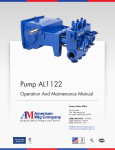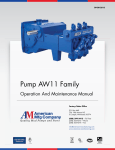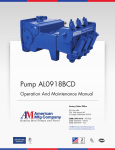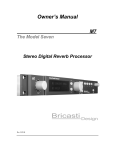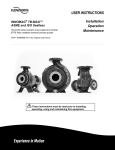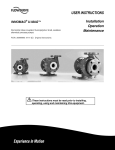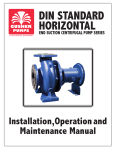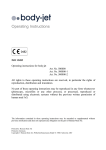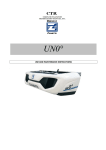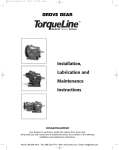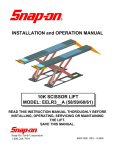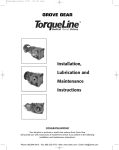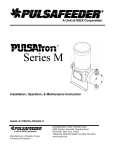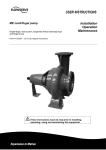Download the American AME0413HD Piston Pump service manual
Transcript
Pump AME0413HD Operation And Maintenance Manual Factory/Sales Office P.O. Box 640 736 19th Avenue NE St. Joseph, Minnesota 56374 (888) 299-3412 ~ Toll Free (320) 363-7273 ~ Phone (320) 363-7274 ~ Fax [email protected] www.american-manufacturing.com 7k-0266 Operation And Maintenance Manual For AME0413HD Pump Summary: This is a manual for American Mfg Company AME0413HD vertical quadruplex piston pump with disc valves. Alternate valve seat option: The standard model AME0413HD comes with PPFMC 5260142 Valve seat, Raised face. Optional valve seat version: PPFMC 1219615 Valve seat, Flat. Page 2 of 38 Factory/Sales Office P.O. Box 640 736 19th Avenue NE St. Joseph, Minnesota 56374 (888) 299-3412 ~ Toll Free (320) 363-7274 ~ Fax (320) 363-7273 ~ Phone 7k-0266 [email protected] www.american-manufacturing.com AME0413HD Piston Pump Data Specifications 6.7 BHP Continuous Duty (8.5 BHP Intermittent Duty) Pump Model AME0413HD Configuration Vertical Quadruplex Piston Number of Pistons 4 Stroke Length 1.0 Inches (25.4 mm) Frame Load Rating 1240 lbs. (562.455 kg) Pump Weight (Average) 80 lbs. (36.29 kg) Direction of Rotation Either Internal Gear Rotation 1:1 Intermittent Duty Speed Rating 575 RPM Continuous Duty Speed Rating 450 RPM Minimum Speed 390 RPM Mechanical Efficiency 85% Lubrication System Splash, Gravity Return Lube Oil Capacity 1 Quart Lube Oil Type SAE 30 Maximum Fluid Temperature 140°F Minimum Fluid Temperature 0°F Standard Suction Size 1.25 Inch NPT Standard Discharge Size 0.75 Inch NPT Fluid End Material Cast Iron Valve Type Disc Valve Performance Rating Pump Model Diameter Inch mm AME0413HD 1.625 41.27 Displacement/ REV Pump Capacity @ Input Speed (RPM) Maximum Pressure 390 RPM 400 RPM 425 RPM 450 RPM 575 RPM Gallon Liter PSI kg/cm gpm lpm gpm lpm gpm lpm gpm lpm gpm lpm 0.036 0.12 550 38.6 14.01 53 14.36 54.35 15.26 57.77 16.16 61.17 20.65 78.17 2 Specifications subject to change without notice. Horsepower is based on 85 or 90% efficiency. Actual application horsepower requirements can be calculated using this equation: BHP = (GPM*PSI)/(1714*0.85 or 0.90) Pump capacities listed are based on 100% volumetric efficiency. This document contains American Mfg Company proprietary and confidential information. It is loaned for limited purposes only and remains the property of American Mfg Company. It may not be reproduced in whole or part or disclosed to third parties without the prior written consent of American Mfg Company. The document is to be returned to American Mfg Company upon request and in all events upon completion of the use for which it was used. Page 3 of 38 Table Of Contents 1.0 Important Safety Instructions................................................................................ 6 2.0 AME0413HD Pump Features.............................................................................. 7 3.0 Storage Instructions........................................................................................... 8 3.1 Short Term Storage........................................................................................... 8 3.2 Short Term Storage for Severe Environments........................................................... 8 3.3 Returning a Stored Pump to Operation.................................................................. 9 3.4 Precautions During Freezing Weather................................................................... 9 4.0 Installation Guidelines........................................................................................ 10 4.1 General Location.............................................................................................. 10 4.2 Mounting Pump to Foundation and Power Source................................................... 10 4.3 Suction Piping Recommendations......................................................................... 10 4.4 Discharge Piping Recommendations..................................................................... 11 5.0 How to Start a Pump......................................................................................... 13 6.0 Lubrication of Power End.................................................................................... 14 6.1 Recommended Lubricants................................................................................... 14 6.2 Oil Changes................................................................................................... 14 7.0 Inspection and Preventative Maintenance Chart...................................................... 16 8.0 Components Parts List........................................................................................ 17 8.1 Power Frame Components................................................................................. 18 8.2 Fluid End Components....................................................................................... 19 9.0 Service Procedures........................................................................................... 20 9.1 Replacing Cup Pistons....................................................................................... 20 9.2 Replacing Suction and Discharge Valves............................................................... 23 9.3 Servicing the Power End.................................................................................... 25 10.0 Fastener Torque Requirements.............................................................................. 28 11.0 Critical Clearances........................................................................................... 29 12.0 Trouble-Shooting Pumps..................................................................................... 30 13.0 Ordering Parts................................................................................................. 33 14.0 Pump Mounting Dimensions................................................................................ 34 15.0 Glossary of Commonly Used Terms...................................................................... 35 16.0 Reference Information........................................................................................ 37 17.0 Maintenance Log............................................................................................. 38 Page 4 of 38 List of Figures and Charts Table 1 MAWP for Steel Pipe........................................................................................ 11 Table 2 Lubricant Recommendations................................................................................ 15 Table 3 Maintenance Chart........................................................................................... 16 Table 4 Component Part List.......................................................................................... 17 Table 5 Torque Values for Critical Pump Fasteners.............................................................. 28 Table 6 Clearance Chart.............................................................................................. 29 Figure 1 AME0413HD Pump Assembly............................................................................ 7 Figure 2 Power End Components..................................................................................... 18 Figure 3 Fluid End Components....................................................................................... 19 Figure 4 Valve Seat Removal Tool.................................................................................... 24 Figure 5 Pump Mounting Dimensions................................................................................ 34 Page 5 of 38 1.0 Important Safety Instructions WARNING: Many accidents occur every year through careless use of mechanical equipment. You can avoid hazards associated with high pressure equipment by always following the safety precautions listed below. SHUT DOWN OR DISENGAGE the pump and all accessory equipment before attempting any type of service. Failure to do this could cause electrical shock or injury from moving pump parts or components under high pressure. Always adhere to “Lock Out” and “Tag Out” procedures. For mobile equipment, be sure engines and hydraulics cannot be accidentally started. BLEED OFF ALL PRESSURE to the pump and piping before performing any maintenance on the pump. Failure to do so may spray water or chemicals at high pressure or high temperature onto service personnel. NEVER OPERATE THE PUMP WITHOUT A PRESSURE RELIEF VALVE, rupture disc, or other type of properly sized over pressure safety device installed. ALWAYS USE A PRESSURE GAUGE when operating the pump. The pressure must never exceed the maximum pressure rating of the pump or damage may occur. This damage can cause leakage or structural damage resulting in injury to personnel. ENSURE THAT NO VALVES ARE PLACED BETWEEN THE PUMP AND PRESSURE RELIEF VALVE. If the pump is started with a closed or restricted valve in line before the pressure relief valve, the pump may exceed the rated or designed pressure limits and rupture causing injury to personnel. USE SHIELDS OR COVERS AROUND PUMPS when pumping hot water, chemicals, or other hazardous liquids. This precaution can prevent the exposure of service personnel to these fluids should leakage occur. ALWAYS USE GUARDS on all belt drives, couplings, and shafts. Guards can prevent personnel from becoming entangled and injured by rotating and reciprocating parts. USE EXTREME CAUTION WITH SOLVENTS used to clean or degrease equipment. Most solvents are highly flammable and toxic. Observe all safety instructions on packaging. FOLLOW NORMAL ENVIRONMENTAL GUIDELINES WHEN fluids, lubricants, or solvents are disposed of or spilled. NEVER MODIFY THE PUMP to perform beyond its rated specifications without proper authorization in writing from AMERICAN MFG COMPANY. Page 6 of 38 2.0 AME0413HD Pump Features The AME0413HD drive shaft standard end comes with 1-1/8” diameter shaft and 1/4” square keyway. Corrosion resistant disc valves are stacked in the fluid end using O-ring seals for easy servic e Polished ceramic cylinders provide unsurpassed wear and corrosion resistanc e Hardened steel wrist pins are ground to a mirror finish for a precise fi t Aluminum alloy connecting rods have wrist pin bushings and split insert bearings Spring-loaded oil seals keep oil in and contaminants out Heavy duty , oversize ball bearings 1-1/8” diameter straight keyed mounting Figure 1: AME0413HD Pump Assembly Page 7 of 38 3.0 Storage Instructions Proper storage of your American Mfg Company pump will ensure that it is ready for service when needed. Follow the guidelines below that fit the requirements of your application. American Mfg Company pumps come from the factory without crankcase oil and are prepared for storage periods of up to six (6) months in proper environmental conditions. Indoor storage in a dry, temperaturecontrolled location is always recommended. If pumps are to be stored short term (less than six (6) months) in a severe environment, they should be prepared using the procedures outlined in the “Short Term Storage for Severe Environments” section 3.2 below. Remember that any fluid that poses an environmental hazard or is toxic must be handled and disposed of properly. 3.1 Short Term Storage If the pump is stored in an indoor, temperature controlled environment for less than six (6) months, no special steps are required to prepare it for storage. As a general rule for pumps in corrosive fluid applications, the fluid end should be drained, flushed with water or other non-corrosive cleanser and compressed air used to blow dry whenever idle. 3.2 Short Term Storage for Severe Environments If the pump has been in service, drain any fluid from pump fluid end, flush the fluid end with water to clean out any of the remaining pumpage and blow dry with compressed air. Pour 1/4 to 1/2 cup of internal rust inhibitor oil described in Table 2 (see Recommended Lubricant Chart, Section 6.2), into the suction and discharge ports of fluid end, and then install pipe plugs in openings. Drain the power end (crankcase) oil and remove the oil fill cap (or plug). Pour ½ to 1 cup of internal rust inhibitor oil described in Table 2 into the oil fill hole and then install the filler cap. Coat all exposed, unpainted metal surfaces (for example, Driveshaft) with preservative oil. Replace the oil fill cap, and then cover the entire pump with a weather resistant covering such as a canvas or plastic tarp. Page 8 of 38 3.3 Returning a Stored Pump to Operation Before operating a pump that has been prepared for storage, drain the preservative and lubricating oil mixture from the power end (crankcase). If the pump has a pinion bearing, remove the rear cover and apply recommended crankcase lubricant (Refer to Table 2 in Section 6.2) to the pinion bearings. Reinstall the rear cover, drain plug, breather/filler cap, piston cup seals, and any other components that were removed for storage. Once these steps have been completed, follow the normal pump start up procedures outlined in this manual. NOTE: American Mfg Company can factory prepare units for long term storage for a nominal fee if specified at the time of order. 3.4 Precautions During Freezing Weather Freezing weather can cause problems for equipment when pumping water-based fluids that expand in volume when changing from a liquid to a frozen solid state. When water is left in a pump fluid end and exposed to freezing temperatures, the expansion of the water as it freezes can rupture the fluid cylinder of the pump and cause equipment damage. Injury may result when starting equipment that has been damaged. Whenever the pump is stored or idle in conditions that are near or below freezing, any water based fluids should be removed from the pump. The best way to do this is to run the pump for a few seconds with the suction and discharge lines disconnected or open to atmosphere. This will clear the majority of the fluid from the pumping chamber as well as the suction and discharge manifolds. After the run, blow compressed air through the fluid end to remove all traces of fluid. Remove the bottom plugs and cylinder covers from the fluid cylinder. Drain the liquid from the discharge valves first and then the suction valves by lifting the valves. This ensures all fluid to be drained from the pumping chamber between the suction and discharge valves. As an alternative to the previous procedure, a compatible antifreeze solution can be circulated through the fluid end. RV antifreeze, propylene glycol, is recommended for this purpose. Remember that any fluid that poses an environmental hazard or is toxic must be handled and disposed of properly. Page 9 of 38 4.0 Installation Guidelines A proper installation is essential to optimal performance, long service life, and reduced maintenance requirements. Take time to thoroughly plan all aspects of your installation. 4.1 General Location It is important to position the pump on as flat and level a surface as possible to assist the splash oil lubrication system. Park mobile equipment, such as sewer cleaner trucks or drilling machines, on as level a surface as possible. Whenever possible the pump should be mounted in a clean, dry location with sufficient lighting and adequate space for easy inspection and maintenance. Locate the pump as close to the suction source as possible to allow for the shortest and most direct routing of the inlet piping. 4.2 Mounting Pump to Foundation and Power Source The AME0413HD pump must be mounted in a vertical position only. Secure the pump to the mounting surface using the holes provided in the pump base. The design of the AME0413HD pump allows the drive shaft to be rotated in either direction. For units that are V-belt driven, check the alignment of the sheaves after the unit is installed on its permanent mounting. Tighten belts to the proper tension as recommended by the belt manufacturer. Verify that the sheaves are in line and parallel to each other with a straight edge. CAUTION: Never operate the pump without the belt guard securely installed. For direct-coupled or spline-driven units, ensure that the shafts are centered and parallel when the driver is mounted to the pump. Follow the coupling maunufacturer instructions for installation procedures and tolerances. CAUTION: Never operate the pump without a shaft guard securely installed. 4.3 Suction Piping Recommendations Poor suction piping practices are a very common source of pump problems. To ensure proper operation it is very important to follow good design practice in the installation of the suction system before the pump is operated. A small amount of additional planning and investment in the piping system usually provides for better pump performance and longer periods between service requirements. It is difficult to diagnose many pump problems without the aid of a suction pressure gauge. For this reason, American Mfg Company recommends that a gauge always be installed in the suction line directly before it enters the pump. The suction line from the fluid source to the pump should be as short and direct as possible. Use rigid piping, non-collapsible hose or a combination of both as circumstances require in your installation. The suction pipe size should be at least equal to or one size larger than the pump inlet. Long piping runs, low suction heads, or indirect Page 10 of 38 pipe routing may require even greater over sizing of the suction line for proper operation of the pump. A suction and discharge pulsation dampener is recommended to reduce the effects of acceleration head to help when suction conditions are not optimal. In some cases it may be necessary to install a booster pump in the suction line of the pump to obtain sufficient pressure for the pump to operate successfully. The suction line must be configured so there are no high spots in the line where air pockets can collect. These pockets may make the pump difficult to prime and cause rough, erratic operation. A drain valve or plug should be installed at the low point of the suction line to allow for draining before freezing conditions or for maintenance. American Mfg Company recommends that all piping be supported independently of the pump. By supporting the piping this way, vibrations are reduced and stress on the pump is kept to a minimum. The use of elbows, nipples, unions, or other fittings should be minimized. Make sure that all joints and connections are airtight. Air leaks reduce the capacity of the pump and can result in cavitation, rough operation, and/or loss of prime. To help isolate mechanical and hydraulic vibrations, American Mfg Company recommends the use of flexible pipe couplings or hose connections between the pump and any rigid piping. Always ensure that calculated system Net Positive Suction Head available, NPSHa, exceeds pump Net Positive Suction Head required, NPSHr, by at least 5 feet (1.5 meters) of water for proper operation of the pump. NPSH requirements for each pump model are provided on the product data sheets available through American Mfg Company or your authorized American Mfg Company reseller. American Mfg Company does not recommend using the pump in static lift conditions without prior factory approval. 4.4 Discharge Piping Recommendations 1. Route the discharge piping in as short and direct a route as possible. Use the same pipe size as the outlet of the pump. In installations where the discharge piping is in excess of 50 feet (15 meters) it is suggested to use the next larger size pipe to minimize friction losses downstream of the pump. CAUTION: Always use pipe or hose that is designed for your particular pressure requirements. Inadequate pressure ratings can allow hose or pipe to fail, resulting in equipment damage and possibly personal injury. Normal hose pressure ratings are clearly marked on the outer surface of the hose. Working pressure ratings for steel pipe can be obtained from the manufacturer or from the chart shown in Table 1. Allowable Working Pressure For Steel Pipe (PSI @ 100F) Pipe Size (inches) Pipe Schedule Number 40 80 160 XX 3/8 1,700 3,800 ---- ---- 1/2 2,300 4,100 7,300 12,300 3/4 2,000 3,500 8,500 10,000 1 2,100 3,500 5,700 9,500 14.5PSI = 1 BAR Table1: MAWP for steel pipe Page 11 of 38 2. Always use a pressure gauge in the pump discharge line. A properly functioning gauge mounted at the pump (and before any valves) is required to accurately determine the operating pressure of a pump and to conduct troubleshooting. 3. Ensure that all piping is supported independently of the pump to reduce vibrations and strain on the pump. Pulsation dampeners on the discharge are recommended to reduce pressure pulsation and resulting vibration. The use of elbows, nipples, unions, or other fittings should be kept to an absolute minimum. Avoid short radius 90° elbows; use two long radius 45° elbows instead. To help isolate mechanical and hydraulic vibrations, American Mfg Company recommends the use of flexible pipe couplings or hose connections between the pump and any rigid piping or the use of pulsation dampeners. 4. A properly adjusted pressure relief valve or rupture disc must be installed directly downstream of the pump to prevent damage or injuries resulting from over pressure or deadhead conditions. The relief valve discharge line must be as large as the pipe outlet of the relief valve. Never install valves in the relief valve discharge line or between the pump and relief valve. American Mfg Company recommends that the discharge be returned to the tank or drain, not back into the pump suction line. 5. It is recommended that a start-up bypass line and valve be installed to allow flow to bypass the relief valve. This allows the pump to start in an unloaded condition (no discharge pressure). Page 12 of 38 5.0 How to Start a Pump CAUTION: Always take special precautions when starting a pump for the first time or after any extended shutdown. Never assume that someone else has properly prepared the pump and system for operation. Always check each component of the system prior to every start-up. The checklist that follows is intended to be a general guide for starting a pump in a typical installation. Every installation is different, and each will have different requirements to ensure safe and successful operation. It is the responsibility of the operator to determine the correct start-up procedure for each installation. 1. Ensure that the drain plug(s) on the bottom of the pump crankcase have been installed and are tight. Ensure that the oil level sight glass, if equipped, has been properly installed. 2. Check the oil level to ensure that the pump is properly filled with non-detergent motor oil, gear lube, or a synthetic oil as described in Table 2 and that the oil has not been contaminated with water or other contaminants. NOTE: American Mfg Company pumps are shipped with no oil in the power frame and must be filled to the proper level with the proper grade of oil prior to start-up. 3. If accessible, check the piston rods to ensure that they are free from abrasive particles or debris. 4. Ensure that the pressure relief valve and all accessory equipment have been installed and properly adjusted. Verify that all joints are pressure tight. 5. Open the suction line valve to allow fluid to enter pump. Prime the fluid cylinder if necessary on the initial start up or after the system piping has been drained. The valve covers may have to be cracked open to assist with priming. 6. Check to ensure that power is locked out and tagged out. Turn the pump over by hand if possible to ensure free, unobstructed operation. 7. Make sure that all guards are in place and secure. Verify that all personnel are in safe positions and that system conditions are acceptable for operation. 8. The pump is now ready to start. NOTICE: Whenever possible, use a bypass in the discharge line to allow the pump to start in the unloaded condition (no discharge and pressure). Slowly close the bypass line to bring the pump into full load conditions. Shut down immediately if the flow becomes unsteady, pressure fluctuates, or if unusual sounds or vibrations are noted. 9. Take temperature readings of the power end and crosshead regions. Do not exceed 170°F (77°C) on power end and crosshead regions. Page 13 of 38 6.0 Lubrication of Power End 6.1 Recommended Lubricants Few factors can influence the life of a pump more than the power end lubricant (oil). Careful selection of the right type of oil for each particular application will help ensure optimal performance from an American Mfg Company pump. NOTE: Lubricant temperatures should not exceed 170° F (77° C) for continuous duty or 180° F (82° C) for intermittent duty applications. Crankcase temperatures that exceed these limits will cause the lubricant to prematurely “break down”. The result will be poor lubrication and failure of power end components. 6.2 Oil Changes Oil changes must be carried out after first 50 hours of operation, and subsequently after every 2,000 hours or at least every 3 months. These intervals may be modified depending on actual operating conditions. This model pump requires 1 quart (.95 liters) of oil. Oil should be changed when hot to prevent build up of sludge deposits. It is advisable to check oil level daily. If more than 10% of the total capacity has to be added, check for oil leaks. Do not mix oils of different types, even if produced by the same manufacturer. Never mix mineral and synthetic oils. To avoid the risk of scalding or burns, pay attention to oil and power end temperature during an oil change. Follow environmental guidelines when changing and disposing of lubricants. Page 14 of 38 Recommended Lubricant Chart Oil Lubricant Type of Service Ambient Temperature General Service 0 F to 100 F (-18 C to 38 C) SAE ISO Viscosity Grade (cSt@40 C) 30 100 Synthetic Lubricant* SSU Viscosity Manufacturer Brand Name SAE Grade ISO Viscosity (cSt@40 C) Manufacturer Brand Name 550 Texaco® Meropa 100 Shell® Omala 100 Shell® Rotella T SAE 30 Exxon® XD-3 30 wt Mobil® Trans HD-30 10W-30 90.0@40 15.0@100 Shell® Rotella T Synthetic SAE 5W-40 5W-40 99.1@40 13.9@100 Mobil® SCH 627 Texaco® Meropa 68 Shell® Omala 220 Shell® Rotella T SAE 50 Exxon® HD-3 50 wt Mobil® Trans HD-50 5W-40 90.0@40 15.0@100 Shell® Rotella T Synthetic SAE 5W-40 5W-40 217@40 29.9@100 Mobil® SCH 630 5W-30 90.0@40 15.0@100 Shell® Rotella T Synthetic SAE 5W-40 5W-40 12.0@100 BP® Vanellus E8 ULTRA 5W-30 10W-30 69.9@100 10.9@100 Mobil® SCH 626 NA High Ambient Temperature Service 100 F to 130 F (38C to 54 C) 50 220 1,165 NA Cold Ambient Temperature Service 0 F to -30 F (-18 C to -34 C) 20 68 350 Texaco® Meropa 68 Shell® Omala 68 Shell® Rotella T SAE 20 Exxon® HD-3 20 wt Mobil® Trans HD-20 NA Frequent Start/Stop Operation 40 150 775 Texaco Meropa®150 Specialty Items Internal Rust Inhibitor Cortec® VCI 329 External Rust Preventative Texaco® Metal Protective Oil L Table 2: Lubricant Recommendations *Synthetic lubricants are suggested for high or low temperature service. Cortec® is a registered trademark of Cortec Corporation, St. Paul, MN. Page 15 of 38 7.0 Inspection and Preventative Maintenance Chart Routine maintenance is an essential part of any successful pump installation. Properly maintained American Mfg Company pumps are designed to offer years of trouble-free service. Regular maintenance and inspection will keep your pump operating at peak performance. American Mfg Company pumps have been carefully engineered to minimize maintenance requirements and simplify these tasks when they are required. Regular inspections allow operators to become familiar with normal pump operation so they can recognize the signals of potential problems and schedule maintenance. The maintenance chart in Table 3 shown below should be used as a guideline only. Many applications will require adjustment of the intervals shown in this chart for severe or unusual operating conditions. Interval Break In Period Daily 2,000 Hours Component Service Remarks Crankcase Oil Change Drain and refill with new oil after first 50 hours of operation. Ensure that the magnetic drain plug is cleaned to remove debris. Inlet Strainer Inspect Clean if required. The amount of material in the strainer will determine the interval of cleaning. Complete Pump Inspect General inspection of pump and system to check for proper operation of equipment. Piston Cup Sets Inspect Check the cylinder liner area of the pump for signs of leakage. Replace piston cups if leakage becomes excessive. Pump System Flush Crankcase Oil Inspect Ensure that the oil is at proper level and has not been contaminated by pumpage or condensation. Crankcase Oil Change Drain and refill with new oil. Clean magnetic drain plugs. Connecting Rod Bolts Inspect Check the connecting rod bolts with a torque wrench to ensure they are within specification. This should be done in conjunction with oil change. Required for shutdown when pumping fluids that may harden or corrode the pump if left inside once stopped. Table 3: Maintenance Chart Page 16 of 38 8.0 Component Parts List To order service parts or see exact component configurations for your particular pump, refer to the cross-section parts drawing. Contact your local American Mfg Company pump distributor or American Mfg Company if you do not have this information. AME0413HD Component Part List Component Description Item # Part # Qty Item # Component Description Part # Qty 1 Power Frame PPFMC 1273545 1 22 Fluid Cylinder PPFMC P500358 1 2 Crankshaft: Driven PPFMC P509560 1 23 Screw PPFMC P522316 4 3 Crankshaft: Drive PPFMC P510882 1 24 Valve Seat, Raised Face PPFMC 5260142 8 4 Connecting Rod Assembly PPFMC P509546 4 25 Disc & Spring Assembly PPFMC 5253499 8 5 Bearing Insert (Pair) PPFMC P510834 4 26 Valve Cage PPFMC 1219610 8 6 Wrist Pin PPFMC 1219650 4 27 O-Ring PPFMC 3264075 12 7 Crosshead PPFMC 1216823 4 28 Valve Cover PPFMC 1219614 4 8 Sleeve PPFMC 1218743 4 29 Valve Cover Clamp PPFMC 1255887 2 9 Ball Bearing, Single PPFMC 1104444 3 30 Screw PPFMC 1100064 2 10 Retainer Ring PPFMC 1118553 4 31 Plug, 1/4” NPT PPFMC 1109987 1 11 Seal, Oil PPFMC 1101095 4 32 Screw PPFMC 1284516 4 12 Ball Bearing, Double PPFMC 1104508 1 33 Piston Retainer PPFMC 5257986 4 13 Washer PPFMC 1177455 12 34 Piston Cup PPFMC 5257807 4 14 Screw PPFMC 1100068 12 35 O-Ring PPFMC 1101339 4 15 Plug, 1/4” NPT PPFMC 1101305 1 36 Piston Holder PPFMC 1282557 4 16 Mounting Base, Pump PPFMC 1280633 1 37 Gasket PPFMC A91684 8 17 Gasket, Pump Base PPFMC 1273559 1 38 Ceramic Liner PPFMC 1241364 4 18 Key PPFMC 1187577 1 39 Umbrella (Plastic) PPFMC 1279148 4 19 Plug, 3/4” NPT PPFMC 1105060 2 40 Washer, Umbrella PPFMC 1269388 4 20 Screw, Drive PPAM A100120000 4 41 Cap Plug For 3/4” NPT PPFMC 1177200 1 21 Nameplate PPAM A000522000 1 42 Cap Plug For 1-1/4” NPT PPFMC 1177202 1 Table 4: Component Part List Page 17 of 38 8.1 Power Frame Components 8 7 6 1 21 9 20 4 19 2 18 3 10 5 17 11 12 16 13 14 15 Figure 2: Power End Components Page 18 of 38 8.2 Fluid End Components 23 22 24 24 27 28 25 26 30 29 31 32 33 34 35 36 37 38 37 39 40 Figure 3: Fluid End Components Page 19 of 38 9.0 Service Procedures American Mfg Company pumps are designed to simplify all required maintenance. The following sections illustrate step-by-step instructions for performing most common service procedures of a pump. Read each section before starting service work on the pump. Refer to figures 2 and 3 in section 8.0 for location of components. CAUTION: Many accidents occur every year through careless use or service of mechanical equipment. You can avoid hazards associated with high-pressure equipment by always following the safety precautions listed in Section 1.0. CAUTION: Ensure that all pressure inside the pump fluid cylinder has been bled off before starting any service work. Ensure that the power to the pump is off. If applicable, it should be locked and tagged out. 9.1 Replacing Cup Pistons 1. Remove the fluid cylinder (22) to provide access the piston cups (34). To remove the fluid cylinder, first remove the four hex bolts (23) holding the fluid cylinder to the power frame (1), then lift it off exposing the ceramic cylinders (38). 2. Remove the gaskets (37) from the top of the cylinders or from the counter bores of the fluid cylinder. 3. Each piston cup (34) is held in place with a cap screw (32) and piston retainer (33). Remove the cap screw and piston retainer from each of the four cylinders. 4. Lift each ceramic cylinder (38) off from the top of the power frame. Friction will usually keep the piston cup inside the cylinder as it is removed. Once the cylinder and pistons are removed, take them to a bench and push the piston cup out of the cylinder. 5. Remove the piston holder (36) and o-ring (35) from the crosshead shaft (7). Page 20 of 38 6. Inspect all o-rings, gaskets, seals, and other components for signs of damage or wear. Any damaged components should be replaced at this time. Inspect the ceramic cylinders for cracks or grooves by visual inspection and running thumbnail around the bore of the cylinder. Replace if grooves, wear or cracks are detected. New piston cups will wear quickly if operated in cylinders with rough or grooved bores. Note: To provide maximum operational time between service, American Mfg Company recommends that all four piston cups, not just the one that shows signs of leakage, be replaced whenever piston service is required. Also, it is recommended that all gaskets and/or o-rings be replaced at each piston cup service interval. 7. The plastic umbrella shields (39) keep any fluid that leaks past the piston cups (34) from entering the power frame and contaminating the oil reservoir. Ensure that the umbrella fluid shield is not damaged. If the umbrella requires replacement, the best way to remove it from the pump is to cut it free with a sharp knife. 8. To install new umbrella shields, fold the plastic as shown and insert through the opening of the crosshead bore of the power frame, and over the ends of the crosshead shaft. For easier installation of the umbrella, immerse in boiling water for 2-3 minutes to soften. Use caution to avoid burns or scalds when working with hot water. 9. Once the umbrellas are installed over the crosshead shaft, lift them up slightly and insert the umbrella washer (40) through the upper opening of the umbrella. Ensure the groove of the washer is facing up. Press the top of the umbrella down to seat over the umbrella washer and crosshead shaft. 10. To rebuild, first place piston o-rings (35) and piston holders (36) in position on ends of crosshead shaft (7). Page 21 of 38 11. Place gaskets (37) and ceramic cylinder in counterbore of power frame. 12. Apply light oil or glycerin around the OD of the piston cups, then place them in the open (top) end of the cylinders. Use thumb to press the cups down firmly into the holder of each cylinder. 13. Insert the piston retainer (33) into the cylinders with the ribbed side facing the piston cup. 14. Secure piston assembly using cap screws (32). Torque to specification per the Fastener Torque table in section 10.0 (See Table 5). 15. Insert gasket (37) in fluid cylinder counterbore using heavy oil or grease to hold in place. 16. Return fluid cylinder to position over cylinders and ensure that all seals are in place. Use a slight twisting motion on the fluid end to ensure all cylinders are fully seated in fluid end counterbores. 17. Replace fluid end cap screws (23). Torque cap screws in 3 stages to specification per the Fastener Torque table in section 10.0 (See Table 5). Page 22 of 38 9.2 Replacing Suction and Discharge Valves 1. To access the suction and discharge valves, the valve cover clamps (29) must be removed from each side of the fluid cylinder. Remove the cap screws (30) and valve cover clamp from the each side of the fluid cylinder. 2. Insert the end of a standard screwdriver into the valve cover groove and pry each of the four the valve covers (28) away from the fluid cylinder. 3. Remove the valve cage (26) and disc-spring assembly (25) from all 4 cylinder bores of the fluid cylinder. 4. Use a finger to reach through the opening at the center of the seat (24) and work the valve seat loose from the fluid cylinder bore. Note, the optional valve seat removal tool (PPFMC 1250638, Figure 4) may be used to simplify this procedure. Page 23 of 38 5. Use the same procedure to remove the suction valve cage, valve disc-spring and valve seat, which are located directly under the discharge valve seat. Turning the valve seat on edge will help it go through the discharge valve seating area easier. Repeat for the remaining three (3) pump cylinders. 6. Inspect all valve components and replace as necessary. NOTE: Even small damage or erosion to the sealing area of the valve or the o-ring can adversely affect the performance of the pump. 7. With the new o-ring (27) in place on each valve seat, place a few drops of light oil around the o-ring to aid in installation. Place each valve seat SQUARELY in the counterbore in the bottom of the fluid cylinder. 8. Place the valve cage (26) on the valve seat (24) and insert the disc and spring assembly (25) inside of the cage on the valve seat. 9. Repeat the previous two steps to install the discharge valve seat and the discharge valve cage. 10. Place the valve covers (28), with o-rings (27) on BOTTOM groove, in place over the valve assembly. 11. Replace valve cover clamp and cap screw and torque to specification per the Fastener Torque table in section 10.0 (See Table 5). Note: Over-tightening the cap screw can damage the valve components. Figure 4: Valve Seat Removal Tool (PPFMC 1250638) Page 24 of 38 9.3 Servicing the Power End CAUTION: Ensure that all pressure inside the pump fluid cylinder has been bled off before starting any service work. Ensure that the power to the pump is off. If applicable, it should be locked and tagged out. 1. Remove bottom drain pipe plug (15) and drain all oil from the power frame. 2. Disconnect suction and discharge piping, power source, and remove pump from mounting base. 3. Although it is not required, it is easier to remove the crankshafts (2,3) if the fluid end and pistons have been removed first. To remove the fluid end, refer to Section 9.1. 4. Remove the 12 hex head cap screws (14), washers (13), and base (16) from bottom of pump. After the base is removed, the pump base gasket (17) can be removed. Take care not to damage the pump base gasket. 5. Remove cap screws (4) from the connecting rod assemblies (4) and take out the back half of connecting rod shell bearings (5). Note the orientation of the machine markings on the connecting rod and cap. NOTE: Connecting rod halves are not interchangeable and must be reassembled in their original orientation and in the same cylinder. 6. Push the connecting rods and crosshead assemblies as far forward into the power frame as possible to provide clearance for the crankshafts. Page 25 of 38 7. Use snap ring pliers to remove the four crankshaft retainer snap rings (10) from each side of the pump. 8. Using a hammer and wood block (or rubber mallet) drive each crankshaft until one bearing (9, 12) on each shaft clears the power frame. Drive from the gear side of the shafts. 9. If bearing replacement is required, remove bearings from the crankshaft using a press. Be sure to provide suitable support for the backside of the bearings during this step. NOTE: Never pound directly on the bearings or they may be damaged. 10. The wrist pin (6) is a slip fit through the connecting rod and crosshead. Check for signs of wear on the pin and connecting rod bushing. For critical clearance dimensions see section 11.0. (Reference Table 6). 11. Replace the pin if noticeable wear is found. The complete connecting rod assembly must be replaced if the bushing is worn, as the wrist pin bushing is not field replaceable. 12. When reassembling the connecting rod and cap, ensure that these parts are reassembled in their exact former orientation and position. 13. Carefully clean and inspect all parts. Replace worn or damaged components as necessary. Page 26 of 38 14. Ensure that timing marks on gears are aligned as shown for proper piston motion. Arrow (or dot) on one gear must be centered between two arrows (or dots) on other gear. 15. Install the crosshead and connecting rod assemblies to their original position in the power frame. 16. Install the crankshafts with bearings in the power frame. 17. Place the oil seals (11) over the ends of the crankshaft with the lip of the seals facing the inside of the power frame. 18. Seat the snap rings in the grooves in the bearing housing against the oil seals and tap the crankshaft to allow a SLIGHT endplay in the crankshaft. 19. Reassemble the connecting rods and shell bearings around the crankshaft. The connecting rod and cap are a matched set. Be sure to properly match the connecting rods and caps back into their original position, orientation, and cylinder. Torque connecting rod bolts to specification per the Fastener Torque table in section 10.0 (See Table 5). 20. Complete the reassembly by reversing steps 1-4. Torque the back cover cap screws (14) and washers (13) to specification per the Fastener Torque table in section 10.0 (See Table 5). 21. Reinstall the drain pipe plug in the mounting base. 22. Refill the power frame with oil and turn the shaft over several revolutions by hand. When piston cups are not installed the pump shaft should rotate freely. See Table 2 in section 6.2 for oil type and filling instructions. NOTE: The AME0413HD pump models require 1 quart (0.95 liters) of oil. Page 27 of 38 10.0 Fastener Torque Requirements NOTICE: No pump service procedure is complete without applying the proper fastener torque. Failure to properly tighten the pump bolts could cause the pump to leak or possibly allow the pump to fail. Always use a calibrated torque wrench during the installation of all critical fasteners listed in Table 5 below. Values are in foot- pounds (Ft-lb) and Newton meters (N-m). Typical sizes are shown in Table 5 below. Torque Requirements Item # Component Description Bolt Size Ft-lb (N-m) Power End 4 Connecting Rod Bolts .313 (5/16) 15 20 32 Piston Assembly Bolts .313 (5/16) 15 20 14 Pump Base Bolts .375 (3/8) 15 20 Fluid End 23 Fluid End Attaching Bolts .4375 (7/16) 60 81 30 Valve Cover Clamp Bolts .500 (1/2) 60 81 Table 5: Torque Values for Critical Pump Fasteners Page 28 of 38 11.0 Critical Clearances When maintenance requiring disassembly of the power end is performed, the following clearances should be checked to see if they are within factory specification or within maximum allowable limits. Additional clearance is allowed for component wear. This additional clearance is a maximum of .002 inches of total diametral wear that can be added to the clearance values in Table 6. For radial clearance, use ½ of the total diametral value. All dimensions are shown in inches. Description Clearance Crankshaft Throw Diameter (Stroke) 1.00 Crankshaft Pin or Journal (OD) 1.1733/1.1743 Connecting Rod / Crank Clearance (Max. Total) .007 Crosshead Diameter (OD) 1.498/1.500 Crosshead Cylinder Bore (ID) 1.501/1.504 Crosshead to Bore Clearance (Max. Total) .006 Wrist Pin Bushing Bore (ID) .560/.562 Wrist Pin to Bore Clearance (Max. Total) .0035 Table 6: Clearance Chart Metric Conversion: 1 inch = 25.4 mm 1 mm = 0.03937 inches NOTE: Clearances shown are total diametral values: For radial clearance use ½ the value shown. Page 29 of 38 12.0 Trouble-Shooting Pumps This chart is designed to aid in the solution of pump and pump system problems. Once the problem has been identified, work through the possible causes and solutions until the problem has been corrected. Symptom No flow from pump Insufficient pressure from pump (ONLY) Insufficient flow from pump (ONLY) Insufficient flow or pressure AND rough operation (pump pounds or vibrates) Possible Cause Possible Solution • No liquid in reservoir (tank) • Ensure lines are connected and fill tank • Inlet line valve closed • Ensure lines are connected and open valve • Inlet strainer is totally clogged with debris • Clean or replace strainer • Crankshaft is not turning • Check for power to drive and drive connections • Pump speed is too low • Check belt tightness or power to motor • Relief valve improperly adjusted or worn • Check relief valve and adjust setting • Insufficient system resistance (worn nozzle) • Properly service system • Worn check valves • Inspect check valves and repair or replace • Excessive leakage from pump seals • Adjust or replace piston cup or damaged parts • Pump speed is too low • Check belt tightness or power to motor • Relief valve improperly adjusted or worn • Check relief valve and adjust setting • Worn pump valves • Inspect pump valves and repair or replace • Excessive leakage from pump seals • Adjust or replace packing or damaged parts • Plunger or piston worn • Replace plunger or piston • Valve seat washed out in fluid cylinder • Repair or replace fluid cylinder • All pump cylinders not primed • Prime all chambers • By-pass or relief is piped back to suction • Pipe back to reservoir (tank) • Inlet line too long or too small in diameter • Increase suction pipe size • Insufficient NPSHA • Provide more NPSH • Air leaks in suction line or fittings • Correct installation to stop leaks • Vortex in tank near inlet pipe opening • Increase submergence or baffle to stop vortex • Pump valve stuck open or closed • Clean and deburr valve • Valve assembly damaged or unseated • Properly seat or repair valve • Valve seat washed out in fluid cylinder • Repair or replace valve seats • Gas pocket formation from high spots in suction • Correct suction line installation Page 30 of 38 Symptom Pump runs rough, knocks, or vibrates (ONLY) Possible Cause Possible Solution • Broken or weak valve spring • Replace disc and spring assembly • Valve damaged or unseated • Repair/replace valve or re-seat • Loose plunger, piston, or rod • Tighten loose components • Low oil level in power end • Fill to proper level • Excessive connecting rod brg clearance • Check cap torque or replace bearings • Excessive main bearing clearance • Adjust end-play • Worn wrist pin or bearing • Replace worn components • Insufficient NPSHA • Provide more NPSH • Excessive acceleration head in suction line • Install suction stabilizer • Pulsation dampener improperly charged • Charge to proper pressure • Inlet line too long or too small in diameter • Increase suction pipe size • Worn piston seal allows air ingress (usually observed when booster not used) • Replace piston seal Rapid suction pressure fluctuation • Pump cavitation • Increase suction size or NPSH • Air is entering suction line • Correct installation to stop leaks Piping vibration • Same as Pump runs rough above • See above • Excessive pressure variation in discharge • Install discharge pulsation dampener • Piping inadequately supported • Install supports at proper locations • Excessive short-radius elbows or tees • Correct installation to minimize turns and shortradius fittings • Discharge pressure too high • Reduce system back-pressure or adjust relief valve • Speed too high • Reduce speed • Misaligned coupling • Correct alignment • Belts too tight • Correctly adjust belt tension • Low motor voltage • Supply correct voltage • Discharge and/or suction pressure too high • Reduce pressure or reduce plunger size • Oil level too high or too low • Adjust to correct oil level • Contaminated power end oil • Refill with clean oil & eliminate contamination • Incorrect oil viscosity or grade • Fill with correct oil • Misaligned coupling • Correct alignment • Belts too tight • Correctly adjust belt tension • Pump located too close to heat source • Remove heat source or insulate power end • Worn or damaged power end bearings • Replace damaged bearings Pump requires excessive power Power end overheats (over 180° F) and/ or reduced power component end life Page 31 of 38 Symptom Possible Cause Possible Solution Crankshaft jerks or starts and stops rotation • Drive belts loose and slipping (if equipped) • Correctly adjust belt tension • System relief valve pressure set too high • Reduce relief valve pressure setting • Discharge line blocked or partially blocked • Clear obstructions from piping system Fluid leaking from pump • Piston cups are worn • Replace piston cup • Piston to rod o-ring damaged • Replace o-ring • Fluid cylinder bolts not properly tightened • Properly tighten and torque bolts • Fluid cylinder o-rings (or gaskets) damaged • Replace damaged o-rings or gaskets • Highly abrasive particles in fluid • Install strainer or filter • Packing or piston cups run dry • Correct problem & replace packing or cup • Incorrect cups for fluid type • Change to correct cup • Pump was run dry for extended time • Correct problem and replace cups • Worn plunger or cup holder • Replace plunger or cup holder • Worn cylinder liner bore • Replace cylinder liner • Highly abrasive particles in fluid • Install strainer or filter • Cavitation damage • Correct problem and replace damaged valves • Air leaking into suction line • Correct problem • Suction inlet insufficiently submerged • Increase submergence or baffle to stop vortex • Relief valve or bypass piped to suction • Pipe back to reservoir (tank) • Valve damaged by improper installation • Replace damaged components • Discharge pressure too high • Reduce system back pressure or relief valve • Hydraulic shock (cavitation or entrained air) • Correct piping system problem • Discharge valve stuck closed • Replace damaged components • Fluid freezing in fluid cylinder • Change procedure to drain fluid when cold • Material or manufacturing defect • Replace defective component • Bolt or nut not properly torqued • Replace fluid cylinder and properly torque • Excessive piping loads on fluid end • Add supports to piping • Discharge pressure too high • Reduce system back pressure or relief valve • Suction pressure too high • Reduce suction pressure or plunger diameter • Fluid freezing in fluid end • Change procedure to drain fluid when cold • Hydraulic shock due to cavitation • Correct piping system problems • Material or manufacturing defect • Replace defective components • Extended operation with failed piston cup • Replace piston cup and improve monitoring • Hi-pressure sprayer nozzle near breather or seals • Provide shields to protect breather and seals • Pony rod seals or umbrella damaged • Replace oil seals or umbrellas Reduced piston cup life Reduced valve life Cracked fluid cylinder or broken fluid end bolts Broken crankshaft or connecting rod Power end oil is contaminated Page 32 of 38 13.0 Ordering Parts Service parts are available through American Mfg Company ’s worldwide network of distributors or from the original supplier. If unsure where to purchase parts, contact American Mfg Company customer service for the location of an authorized parts retailer in your area. Always insist on genuine American Mfg Company replacement parts. Use the assembly drawing and bill of material included on pages 17, 18, and 19 with this manual to determine the components and corresponding part numbers required to service the pump. Make sure that the model number on the drawing or bill of material matches the model number of the pump requiring parts. When ordering parts, always reference the model number of the pump with the order. These numbers can be found stamped on the metal name tag affixed to the power end of every pump. By referencing these numbers you can ensure that the components you receive work as intended with your pump. Be sure to inquire about any special service tools or complete maintenance kits. Page 33 of 38 14.0 Pump Mounting Dimensions 7.45 [189] 3.69 [94] 1-1/4 NP T SUCTIO N 3/4 NP T DISCHARGE 1.500 [38] DRIVEN CRANK 8.86 [225] DRIV E CRANK 8X .438 [Ø 11.11] 2.86 [73] 2X 2.19 [56] 2X 3.75 [95] 4.72 [120] 1.12 [29] 3.86 [98] 1/4" SQ X 1.75" LG KE 12.0 [305] Y 7.51 [191] 7.79 [198] 4.31 [1 10] 9.00 [229] 4.31 [1 10] 4.50 [1 14] 9.8 [249] 4.22 [107] 4.9 [124] 17.6 [447] 2.63 [67] 8.56 [217] Figure 5: Pump Mounting Dimensions Page 34 of 38 15.0 Glossary of Commonly Used Terms CAPACITY -- The total volume throughput per unit of time at suction conditions. It includes both liquid and any dissolved or entrained gases. For all practical purposes this can be considered the volume flow rate in the suction pipe. The standard unit of pump capacity is U.S. gallons per minute (GPM) and metric cubic meters per hour (m3/ hr). CAVITATION -- The state where fluid pressure drops below vapor pressure, causing the liquid to begin to change from a liquid to a gas and boil. Usually occurs in the chamber between the suction and discharge valves during the suction stroke, and often sounds like a mechanical knock. Cavitation results in the formation of gas bubbles, or cavities, in the fluid that cause vibration and damage to components when they collapse. DAMPENER -- A device that reduces pressure pulsations in the suction or discharge piping. This may be referred to as a suction stabilizer, accumulator, or surge suppressor. DISPLACEMENT -- The volume swept by all pistons or plungers per unit time. This term is typically expressed as gallons per revolution. FLOODED SUCTION -- Implies that the level of liquid in the suction vessel is above the centerline of the suction port of the pump. FLUID END -- The portion of the pump that converts the linear motion supplied by the power end into fluid flow at pressure. This may also be called the Liquid End. It is called a valve chamber in old literature. MECHANICAL EFFICIENCY -- Mechanical efficiency (ME) is the ratio, expressed as a percentage, of pump power output to the pump power input. The mechanical efficiency of reciprocating pumps is very high, typically 85% to 90%. NPSHa -- An abbreviation that stands for Net Positive Suction Head Available. NPSHA is the total suction pressure, including allowance for acceleration head, available from the system at the pump suction connection, minus the vapor pressure of the liquid at actual pumping temperature. NPSHA for a reciprocating pump is normally expressed in units of feet of water. NPSHr -- An abbreviation that stands for “Net Positive Suction Head Required”. This is the minimum total inlet pressure required by the pump for proper operation. This value is a function of pump design and speed and is determined by the pump manufacturer through a specific NPSH test. NPSHA should exceed NPSHR by at least 5 feet. Page 35 of 38 PISTON PUMP -- A type of power pump that uses a cylindrical seal (piston) mounted on a holder to drive fluid through the valves. The piston seal reciprocates within a stationary cylinder. PLUNGER PUMP -- A type of power pump that uses a cylindrical plunger to drive fluid through the valves. The plunger reciprocates through a stationary set of seals known as packing. POWER END -- The portion of the pump that converts supplied rotary motion into linear motion used by the Fluid End to move the pumpage. POWER FRAME -- The major portion of a power pump that encloses and supports all other components of the power (or drive) end. It is called a pump case in old literature. POWER PUMP -- A reciprocating pump that drives the pumping element(s) using a slider crank mechanism. Power pumps are piston, plunger, or diaphragm type. All require a driver with a rotating shaft, such as a motor or engine, as a power source. PUMP VALVE -- A check valve that allows flow of liquid in one direction. American Mfg Company pumps have a series of two valves, one suction (inlet) and one discharge, per pumping cylinder. STROKE LENGTH -- The length of one complete, unidirectional motion of the piston or plunger. Stroke length is usually expressed in inches. VOLUMETRIC EFFICIENCY -- Volumetric efficiency (VE) is the ratio of actual pump capacity output to theoretical displacement. The volumetric efficiency is affected by the fluid being pumped and the discharge pressure. Page 36 of 38 16.0 Reference Information Use the following section to record key information about your specific pump model. Information such as part and serial numbers will be needed when ordering service parts. This data may be found stamped on the metal nameplate located on the pump power frame. This area may also be used to make notations about special parts, procedures, phone numbers, or other important information related to your pump. Pump Model ________________________________________ Serial Number ________________________________________ Rated Pressure ________________________________________ Rated Capacity ________________________________________ Rated Speed ________________________________________ Notes: Page 37 of 38 17.0 Date Maintenance Log Service By Service Performed Remarks Page 38 of 38






































